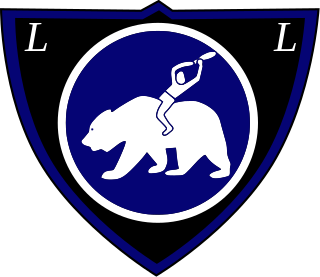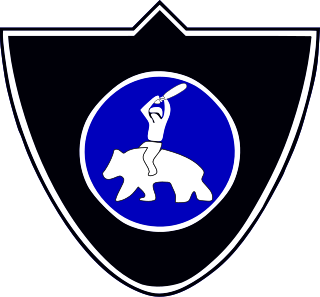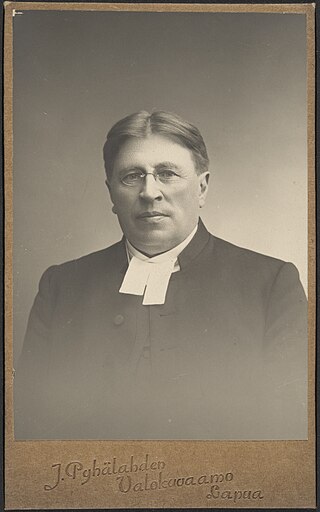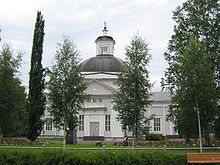
The Lapua Movement was a radical Finnish nationalist, fascist, pro-German and anti-communist political movement founded in and named after the town of Lapua. Led by Vihtori Kosola, it turned towards far-right politics after its founding and was banned after a failed coup d'etat attempt in 1932. The movement's anti-communist activities continued in the parliamentarian Patriotic People's Movement.

Patriotic People's Movement was a Finnish nationalist and anti-communist political party. IKL was the successor of the previously banned Lapua Movement. It existed from 1932 to 1944 and had an ideology similar to its predecessor, except that IKL participated in elections with limited success.

The Mäntsälä rebellion was a failed coup attempt by the Lapua Movement to overthrow the Finnish government.

The .338 Lapua Magnum is a rimless, bottlenecked, centerfire rifle cartridge. It was developed during the 1980s as a high-powered, long-range cartridge for military snipers. Due to its use in the War in Afghanistan and the Iraq War, the cartridge has become widely available.

Lapua is a town and municipality of Finland.

Iisakki Vihtori Kosola was the leader of the Finnish right-wing radical Lapua Movement.

Carl Ludvig Engel, or Johann Carl Ludwig Engel, was a German architect whose most noted work can be found in Helsinki, which he helped rebuild. His works include most of the buildings around the capital's monumental centre, the Senate Square and the buildings surrounding it. The buildings are Helsinki Cathedral, The Senate, the Helsinki City Hall, and the library and the main building of Helsinki University.

Hohenlockstedt is a municipality in the district of Steinburg, in Schleswig-Holstein, Germany. It is situated approximately 8 km northeast of Itzehoe. Hohenlockstedt was formerly known as Lockstedter Lager and was used as a training area in Holstein until 1927.
Nammo, short for Nordic Ammunition Company, is a Norwegian/Finnish aerospace and defence group specialized in production of ammunition, rocket engines and space applications. The company has subsidiaries in Finland, Germany, Norway, Sweden, Switzerland, Spain, the United Kingdom, the Republic of Ireland, and the United States. The company is owned 50/50 by the Norwegian government and the Finnish defence company Patria. The company has its headquarters in Raufoss, Norway.

Kalevi Ilmari Kiviniemi is a Finnish concert organist. He has given over 2000 concerts, and his discography includes nearly 200 titles, many of them featuring significant and unique organs across the US, Japan, the Philippines, Australia, Italy, France, Switzerland and Germany. Kiviniemi is also considered to be a distinguished improviser, especially in the tradition of a French line that runs from Charles Tournemire through to Pierre Cochereau.

Wilhelm "Wilhelmi" Malmivaara was one of the leaders of Finnish Awakening in the beginning of the 20th century. He was a member of the synod of the Evangelical Lutheran Church of Finland in 1898, 1908, 1913 and 1918 and was also a representative of the clergy in the pre-independence Diet of Finland in 1897, 1899, 1900 and 1904–05 and a member of the Parliament of Finland, representing the Finnish Party from 1907 to 1918 and the National Coalition Party from 1918 to 1920.

Two-stage presidential elections were held in Finland in 1931. On 15 and 16 January the public elected presidential electors to an electoral college. They in turn elected the President.The result was a victory for Pehr Evind Svinhufvud, who won on the third ballot by just two votes. The turnout for the popular vote was 47.3%.
Arvi Einar Malmivaara was a Finnish Lutheran clergyman and politician. He was a member of the Parliament of Finland from 1935 to 1939, representing the Patriotic People's Movement (IKL). He was also active in the Lapua Movement.
The Lapua Cartridge Factory explosion was an industrial disaster in an ammunition factory in Lapua, Finland on 13 April 1976. Forty workers were killed and 60 people injured. This was Finland's worst industrial disaster.

Onni Happonen was a Finnish politician representing the Social Democratic Party of Finland. He was kidnapped and murdered by the fascist Lapua Movement.
Johannes (Jussi) Muilu was a farmer from Southern Ostrobothnia, Finland who was active in the Lapua Movement in the early 1930s.

The Peasant March was a demonstration in Helsinki on 7 July 1930 by the far-right Lapua movement, attended by more than 12,000 supporters from all over the country. It was the most significant show of strength in the short history of the Lapua movement, aimed primarily at the Communists, but it was also intended to put pressure on the Finnish government. President Lauri Relander, Prime Minister Pehr Evind Svinhufvud, among others, were invited guests at the main event held at the Senate Square. In addition present were right-wing MPs, the country's military leadership, and General Mannerheim, commander-in-chief of the Civil War White Army. The peasant march was intentionally reminiscent of the White Victory Parade of 16 May 1918, and also followed its route.

Martti Aleksander Pihkala was a National Coalition Party MP who became known as a Jäger activist, Ostrobothnia White Guard founder, in the 1920s and 1930s, leader of the strikebreaking organisation Export Peace, also known as "Pihkala's Guard" and an influencer of the Lapua movement and the Patriotic People's Movement.

The Vaasa riot took place on 4 June 1930 in Vaasa, Finland. The riot unfolded with a violent attack by radical members of the right wing Lapua Movement on Communist supporters and bystanders at a court house in Vaasa. No intervention was witnessed of the police, as the police stood watching the attack.
















